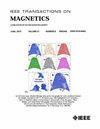种子层退火对Cu种子层沉积Pt/Co/Pt三层薄膜垂直磁各向异性的影响
IF 2.1
3区 工程技术
Q3 ENGINEERING, ELECTRICAL & ELECTRONIC
引用次数: 0
摘要
将具有垂直磁各向异性(PMA)的Pt/Co/Pt三层薄膜沉积在具有Cu种子层的Si衬底上,并在不同温度下对其进行热退火以改变其表面粗糙度。退火温度高达$475~^{\circ}$ C时,在5 nm厚的Cu种子层中晶粒明显长大,表面粗糙度显著提高。在$500~^{\circ}$ C时,Cu种子层的均方根粗糙度(rms)超过了Co层的0.8 nm厚度,可能会破坏其连续性。这种表面粗糙度的增加产生了钉住点,通过阻碍畴壁运动,显著提高了矫顽力,与沉积时的三层相比,矫顽力提高了约430%。然而,$500~^{\circ}$ C的过度粗糙度削弱了Co自旋之间的铁磁交换相互作用,降低了PMA和矫顽力。磁畴图像显示,Cu层粗糙度的增加促进了新的畴核位的形成,同时降低了畴壁速度。这些结果表明,Pt/Co/Pt层的垂直磁性能可以由下伏种子层的微观结构特征控制。本文章由计算机程序翻译,如有差异,请以英文原文为准。
Effect of Seed Layer Annealing on Perpendicular Magnetic Anisotropy in Pt/Co/Pt Trilayers Deposited on Si Substrates With Cu Seed Layers
Pt/Co/Pt trilayers with perpendicular magnetic anisotropy (PMA) were deposited onto Si substrates with Cu seed layers, which were thermally annealed at various temperatures to alter their surface roughness. Annealing at temperatures up to $475~^{\circ }$ C induced significant grain growth in the 5 nm thick Cu seed layer, substantially increasing its surface roughness. At $500~^{\circ }$ C, the root-mean-square (rms) roughness of the Cu seed layer surpassed the 0.8 nm thickness of the Co layer, potentially disrupting its continuity. This increased surface roughness created pinning sites that significantly enhanced coercivity—up to approximately 430% compared to the as-deposited trilayer—by impeding domain wall motion. However, the excessive roughness at $500~^{\circ }$ C weakened ferromagnetic exchange interactions between Co spins, diminishing PMA and coercivity. Magnetic domain images revealed that the increasing Cu layer roughness promoted the formation of new domain nucleation sites while reducing domain wall velocity. These findings demonstrate that the perpendicular magnetic properties of the Pt/Co/Pt layer can be controlled by the microstructural characteristics of the underlying seed layer.
求助全文
通过发布文献求助,成功后即可免费获取论文全文。
去求助
来源期刊

IEEE Transactions on Magnetics
工程技术-工程:电子与电气
CiteScore
4.00
自引率
14.30%
发文量
565
审稿时长
4.1 months
期刊介绍:
Science and technology related to the basic physics and engineering of magnetism, magnetic materials, applied magnetics, magnetic devices, and magnetic data storage. The IEEE Transactions on Magnetics publishes scholarly articles of archival value as well as tutorial expositions and critical reviews of classical subjects and topics of current interest.
 求助内容:
求助内容: 应助结果提醒方式:
应助结果提醒方式:


